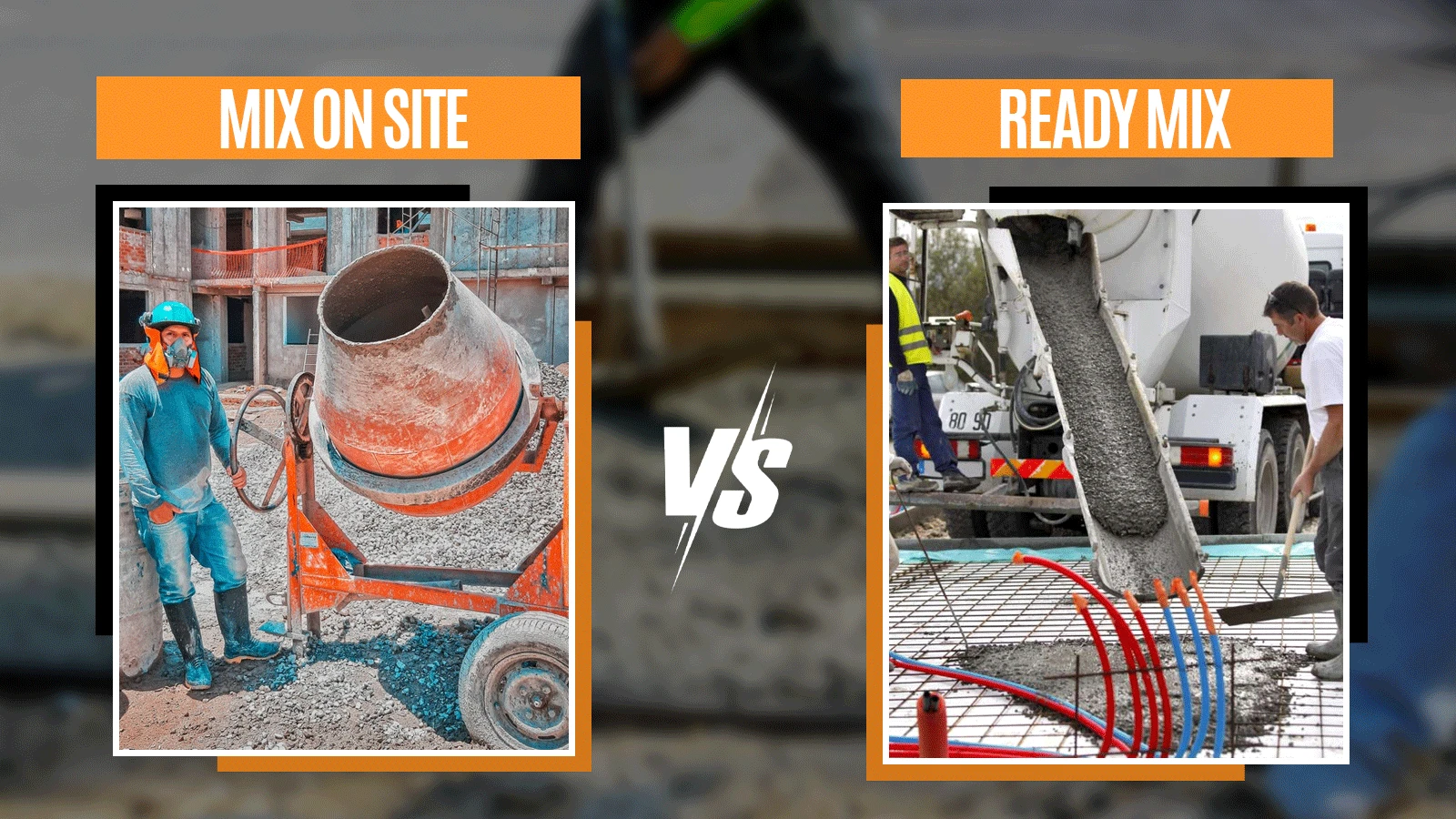[TL;DR]
Choosing between Mix On Site vs Ready Mix impacts your project’s flexibility, cost, and schedule. Mix on site offers real-time customisation, perfect for small or unpredictable jobs. Ready mix provides consistent quality and faster delivery for large-scale projects. Pro-Mix Concrete offers both options with expert guidance and same-day service across the UK.
Choosing between ready-mix concrete and site-mix concrete can make or break your construction timeline. Both methods offer unique advantages, but flexibility varies significantly depending on your project needs. Ready-mix concrete provides consistent quality and faster delivery, while mix-on-site offers real-time customisation. Your choice impacts everything from project costs to completion times.
Construction delays cost the UK economy £8.6 billion annually, with 40% of delays caused by material delivery issues and mixing problems. Choosing the right concrete delivery method has never been more critical for project success. The UK is planning £121.7 billion in building sector investments by 2050.
Are you in need of ready-mix concrete for large-scale projects? Our specialised mix-on-site service for custom applications, Pro-Mix Concrete, delivers both options across London and the UK. Our 20+ years of experience help you choose the right concrete solution with same-day or next-day delivery to keep your project on schedule.
Get Expert Concrete Advice: 020 7458 4747
What Is Mix On Site Concrete?
Mix-on-site concrete involves bringing raw materials to your construction location and mixing them fresh as needed. This method uses portable concrete mixers or volumetric concrete trucks that combine cement, aggregates, water, and additives at your project site.
Common applications include:
- Remote construction sites
- Small residential projects
- Projects requiring multiple concrete grades
- Areas with difficult access for ready mix trucks
Materials and Equipment Required for On-Site Mixing
On-site concrete mix requires several key components. Cement, sand, gravel, and water must be stored and managed at your construction site. Portable mixers or volumetric trucks handle the actual mixing process.
Storage considerations include weather protection for cement and proper drainage for aggregates. Quality materials ensure consistent concrete performance regardless of mixing location.
Advantages of On-Site Mixing (Flexibility, Adjustments)
Mix-on-site concrete offers unmatched flexibility for project adjustments. You can modify concrete strength, add admixtures, or adjust consistency based on real-time conditions.
Key flexibility benefits include:
- Instant mix design adjustments
- No waste from unused concrete
- Extended working time without time constraints
- Perfect for unpredictable project schedules
Pro-Tip:
Start with conservative mix designs when mixing on site, then adjust strength and workability based on actual placement conditions.
Challenges and Quality Control Considerations
- On-site mixing presents quality control challenges. Human error can affect concrete strength and durability. Weather conditions impact mixing consistency and material quality.
- Proper training and equipment calibration help maintain quality standards. Regular testing ensures concrete meets specification requirements throughout your project.
At Pro-Mix Concrete, our certified professionals handle all quality control aspects for both ready mix and mix-on-site services. We provide custom mix designs tailored to your project specifications.
What Is Ready Mix Concrete?
Ready-mix concrete gets produced at specialised plants using computer-controlled batching systems. Raw materials are precisely measured, mixed, and delivered to your site in transit mixers that maintain concrete quality during transport. Central plants use automated systems that ensure consistent batching accuracy. Moreover, quality control laboratories test every batch to meet specification requirements.
Advantages of Ready Mix (Consistency, Time Efficiency)
Ready mix concrete delivers exceptional consistency and time efficiency. Computer-controlled batching eliminates human error in material proportioning. Professional quality control ensures every batch meets your specifications.
Time-saving benefits include:
- No on-site material storage requirements
- Faster concrete placement
- Reduced labour costs
- Consistent quality across large pours
Limitations Regarding Flexibility and Scheduling
Ready mix concrete requires advanced scheduling and has limited flexibility once production begins. Delivery timing depends on plant capacity and traffic conditions. Mix design changes require new batch orders.
Note:
Ready mix concrete reduces placement time by 60% compared to on-site mixing, but requires 24-48 hours’ advance notice for schedule changes.
Typical Applications and Project Scales
Ready-mix concrete works best for large-scale projects with predictable schedules. High-rise buildings, infrastructure projects, and commercial developments benefit from ready mix consistency and efficiency.
Ideal applications include:
- Large foundation pours
- Structural concrete elements
- Commercial and industrial projects
- Time-sensitive construction schedules
Comparing Flexibility: Mix On Site vs. Ready Mix
Ready mix concrete vs site mix concrete flexibility depends on your specific project requirements. Each method offers distinct advantages for different construction scenarios.
Scheduling and Timing Flexibility
Mix on site provides ultimate scheduling flexibility. You can produce concrete exactly when needed without coordinating delivery schedules. Ready mix requires planning but offers predictable delivery timing. Weather delays affect both methods differently. On-site mixing can pause and resume easily. Ready mix deliveries might face rescheduling challenges during adverse weather conditions.
Ability to Customise Mix Design on the Fly
On-site mixing allows real-time mix adjustments based on placement conditions. You can increase or decrease water content, add admixtures, or modify aggregate ratios as needed. Ready mix customisation requires advanced notice and new batch orders. However, experienced drivers can make minor adjustments within acceptable limits during delivery.
Handling Changes and Project Adjustments
Construction changes favour on-site mixing flexibility. Design modifications, quantity adjustments, and specification changes are easier to accommodate with on-site equipment. Ready mix changes require communication with dispatch and potentially new delivery schedules. However, established suppliers like Pro-Mix Concrete maintain flexible scheduling to accommodate reasonable project changes.
Pro-Mix Concrete’s network of local suppliers ensures we can adapt to your changing project needs with minimal disruption. Our same-day and next-day delivery options, combined with our concrete pump hire services, provide the flexibility you need while maintaining professional quality standards. We understand construction timelines change, so we work with you to keep your project moving forward.
Schedule Your Concrete Delivery Now: 020 7458 4747
Impact on Project Management and Workflow
Project workflow differs significantly between mixing methods. On-site mixing requires material management, equipment operation, and quality control coordination. Ready mix simplifies logistics but requires precise scheduling coordination. Workforce requirements vary, too, as on-site mixing needs trained operators and quality control personnel. While ready mix allows crews to focus on placement and finishing rather than production.
Quality and Consistency Considerations: Mix On Site vs. Ready Mix
Quality control approaches differ between ready mix concrete vs site mix concrete methods. Each system has unique advantages and potential challenges for maintaining consistent concrete quality.
Control Over Mixing Parameters
On-site mixing provides direct control over all mixing parameters. Operators can adjust mixing time, water content, and admixture dosage based on immediate conditions. Ready mix plants use automated controls that ensure precise batching and mixing consistency. Computer systems eliminate human error in material proportioning and mixing procedures.
Risk of Human Error and Variability On Site
Human error represents the biggest quality risk with on-site mixing. Incorrect material proportions, inadequate mixing time, or improper admixture dosing can compromise concrete quality. Training and standardised procedures help minimise these risks. Regular equipment calibration and material testing ensure consistent quality throughout your project.
Automated Systems and Quality Assurance in Ready Mix
Ready mix plants employ sophisticated quality assurance systems. Automated batching eliminates proportion errors. Laboratory testing verifies concrete properties before delivery.
Quality control measures include:
- Computer-controlled batching accuracy
- Regular material testing and certification
- Standardised mixing procedures
- Professional quality assurance oversight
Reality Check:
Professional ready mix production is a valuable investment. The stakes are higher now. The UK government plans 2.6% of GDP in infrastructure investment annually. Reliable concrete delivery is essential for national targets.
Impact on Structural Performance and Durability
Consistent concrete quality impacts structural performance. Proper mixing ensures uniform strength development. It also provides resistance to environmental factors.
Ready mix consistency typically produces more predictable structural performance. On-site mixing can achieve excellent results with proper procedures and quality control oversight.
Cost Implications Related to Flexibility
Cost considerations extend beyond initial concrete prices. Both mixing methods have unique cost structures that impact overall project economics and flexibility requirements.
Upfront and Long-Term Cost Differences
On-site mixing requires equipment investment or rental costs. Material storage and handling add logistical expenses. However, you pay only for the concrete actually used. Ready mix involves higher per-cubic-meter costs but eliminates equipment and storage expenses. Minimum order quantities might increase costs for small projects.
Waste Reduction and Material Efficiency
On-site mixing minimises waste by producing exact quantities needed. You can adjust batch sizes based on actual placement requirements without ordering surplus concrete. Ready mix typically requires ordering 10-20% extra concrete to ensure adequate supply. However, efficient scheduling and accurate quantity estimation can minimise waste significantly.
Labour and Equipment Expenses
Labour costs differ substantially between mixing methods. On-site mixing requires skilled operators, material handlers, and quality control personnel. Equipment rental or purchase adds significant expenses. Ready mix reduces on-site labour requirements. Crews focus on placement and finishing rather than production activities. This often results in lower overall labour costs for larger projects.
Cost Risks When Adjusting Mix On Site
Mix adjustments carry cost risks with both methods. On-site modifications might require additional materials or admixtures. Ready mix changes could necessitate new batch orders or delivery charges. Proper planning and specification accuracy help minimise adjustment costs regardless of the mixing method selection.
Environmental and Logistical Factors
Environmental impact and logistical considerations influence concrete mixing method selection. Both approaches have distinct sustainability profiles and operational requirements.
Transport and Delivery Logistics for Ready Mix
Ready mix requires coordinated delivery scheduling and site access planning. Transit mixers need adequate road access and turning space. Traffic conditions can affect delivery timing and concrete quality.
Delivery logistics include:
- Route planning and traffic considerations
- Site access requirements for large vehicles
- Coordination with placement crews
- Backup delivery arrangements for delays
Raw Material Storage and Management on Site
On-site mixing requires substantial material storage and management capabilities. Cement storage needs weather protection. Aggregates require proper drainage and contamination prevention. Storage considerations impact site layout and logistics. Adequate space and proper storage methods ensure material quality and workplace safety throughout your project.
Waste Generation and Sustainability Considerations
Both methods generate different types and amounts of waste. On-site mixing produces minimal concrete waste but generates packaging and storage-related waste materials. Ready mix trucks require washing, creating wash water that needs proper disposal. However, centralised production often achieves better overall resource efficiency through optimised batching and quality control.
When to Choose Mix On Site for More Flexibility
Specific project conditions favour on-site mixing for maximum flexibility. Understanding these scenarios helps you make informed decisions about concrete production methods.
Small Projects and Remote Locations
Small residential projects often benefit from on-site mixing flexibility. Driveways, patios, and small foundations typically require modest concrete quantities that match on-site production capabilities perfectly. Remote locations without ready mix plant access make on-site mixing practical or necessary. Transportation costs and delivery logistics often favour local material sourcing and on-site production.
Projects Requiring Frequent Mix Adjustments
Projects with varying concrete requirements throughout construction benefit from on-site mixing flexibility. Different foundation depths, changing soil conditions, or multiple structural elements might require different concrete specifications. Decorative concrete projects often need color or texture adjustments based on aesthetic requirements. On-site mixing allows real-time modifications to achieve desired appearance and performance characteristics.
Limited Access or Equipment Constraints
Tight construction sites with limited access favour on-site mixing equipment. Small mixers can navigate spaces where ready mix trucks cannot operate effectively. Equipment constraints, such as crane availability or placement logistics, might require flexible concrete production timing that on-site mixing provides better than scheduled deliveries.
When Ready Mix Provides Adequate or Better Flexibility
Large-scale projects and specific quality requirements often favour ready-mix concrete despite perceived flexibility limitations. Professional production and delivery systems offer their own forms of operational flexibility.
Large-Scale or High-Precision Projects
Ready mix concrete vs site mix concrete becomes clear-cut for large projects requiring consistent quality and high production volumes. Structural concrete, bridge construction, and commercial buildings need a reliable concrete supply and quality assurance. High-precision projects benefit from computer-controlled batching accuracy and professional quality control oversight. Laboratory testing and certified mix designs ensure specification compliance throughout construction.
Tight Deadlines and Consistent Quality Demands
Time-critical projects favour ready mix efficiency and predictability. Continuous concrete supply eliminates production delays and maintains construction momentum during large pours. Consistent quality reduces inspection time and eliminates costly repairs or replacements. Professional production minimises variables that could impact concrete performance or structural integrity.
Projects with Established Mix Designs and Schedules
Well-planned projects with established specifications and schedules maximise ready mix advantages. Advance planning allows optimal production scheduling and delivery coordination. Established mix designs benefit from plant optimisation and quality control procedures. Professional suppliers like Pro-Mix Concrete maintain extensive mix design libraries and testing data for common applications.
Final Winner
Ready mix concrete emerges as the winner for most construction projects when considering overall flexibility, efficiency, and quality. While mix-on-site offers superior customisation capabilities, ready mix provides the perfect balance of flexibility, consistent quality, and operational efficiency that modern construction demands. The professional quality control, predictable scheduling, and reduced on-site complexity make ready mix the smarter choice for contractors who value reliability alongside flexibility.
Pro-Mix Concrete brings 20+ years of expertise to help you navigate the ready mix concrete vs site mix concrete decision. Our team understands that every project has unique flexibility requirements. Don’t let concrete decisions delay your project, as we provide fast, professional concrete at your doorstep that keeps your construction timeline on track.
Call Pro-Mix Concrete Now! 020 7458 4747
Frequently Asked Questions
Which method offers more control over the concrete mix?
Mix-on-site concrete provides superior control over mixing parameters. Operators can adjust water content, admixtures, and consistency in real-time based on placement conditions.
Can ready-mix concrete be customised on delivery?
Ready mix customisation requires advanced notice for significant changes. However, experienced drivers can make minor water adjustments within specification limits during delivery.
How does mixing on-site impact project timelines?
Mix on site eliminates delivery scheduling constraints but requires additional setup time. Projects can start concrete work immediately without coordinating delivery schedules.
Are there environmental benefits to one method over the other?
Both methods offer environmental advantages. On-site concrete reduces transportation emissions and concrete waste. Ready mix provides better resource efficiency through centralised production.
Which option reduces material waste more effectively?
Mixing on-site concrete minimises waste by producing exact quantities needed. You can adjust batch sizes based on actual placement requirements without surplus concrete.
Can small contractors benefit from ready mix for flexibility?
Small contractors benefit from ready mix by eliminating equipment investment and material storage requirements. Professional quality control reduces risk while maintaining schedule flexibility.
- Dennis Broderick
- Dennis Broderick is the founder and owner of Pro-Mix Concrete Company, a trusted name in ready-mix concrete solutions across the UK. With over 20 years of hands-on experience in the construction and concrete industry, Dennis brings unmatched expertise, practical insights, and a commitment to quality on every project - from residential driveways to large-scale commercial developments.
BlogNovember 26, 2025Ready Mix Concrete Costs UK: 7 Key Factors That Affect Your Price Per m³
BlogNovember 26, 2025How Long Does Concrete Take To Cure?
BlogNovember 20, 2025How To Measure Concrete With A Concrete Calculator?
BlogNovember 15, 2025What is the Mix Proportion of Concrete?









